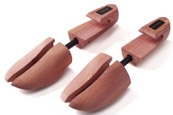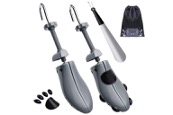Boot Tree vs Shoe Tree can easily be confused as their reasons for use are somewhat intertwined.
Their main differences border on their respective places of use, and in a little part of their construction.
While it has become a tad difficult to tell them apart, how would you feel if you were given easy ways to identify them such that you can, with ease, effectively tell and employ each of them in their appropriate place of use?
Firstly, let’s see their biggest differences.
Before then, it is important that you have to know this shortly; both boot trees and shoe trees are employed to help reduce the extent of creasing in shoes. Both of which are put in shoes when shoes are not in use.
What is the biggest difference between Boot Tree and Shoe Tree?
Table of Contents
- Shoe trees for shoes and boot trees for boots
- Price
1. Shoe trees for shoes and boot trees for boots
Simply put, shoe trees are used in shoes because that is their factory design purpose. They cannot reach certain parts of boots and prevent creasing where boot trees are great.
Meanwhile, boot trees are used in boots because that is where they will be more ideal and better serve their intended purpose.
2. Price
There is a difference in the respective pricing of shoe trees and boot trees. This is because it costs more wood volume to make one than the other. More specifically, a wood tree is pricier because it consumes more wood volume.
What should you know about shoe trees?
Basically, a shoe tree is a device whose primary purpose of creation is to help slash down creasing extent and for moisture absorbance.
This device is foot-like, approximating the foot’s shape, and is used when the shoe is not in use. More often than not, shoe trees have helped in the extension of the lifespan of shoes.
How does a shoe tree function as regards moisture absorbance?
It is common knowledge that porous materials and surfaces are good absorbers of moisture. How most boot trees are able to absorb moisture easily is because they are made from cedar trees.
One of the best and sufficient wood types that work great for moisture absorption is cedar trees owing to their natural porous nature.

What types of shoe trees are there?
There are different types of shoe trees ranging from their materials of construction to their different designs. For example, there are certain types made of wood, and others made of synthetic and polymeric materials.

The type of shoe tree that one gets is dependent on the specific shoe needs at that point in time.
This is cool though, yeah. It is definitely going to be disastrous at a point in time if all shoe trees are made in a model of “one-type-for-all.”
There is a wooden shoe tree too. This type is pricier than plastic shoe trees. It lasts longer and it is sturdier.

Shoe trees come in many iterations. While some have a bit of heel support, others do not. Some have extremely low heel areas while some are an intermediate between high and low heel areas.
What should you know about boot trees?
A boot tree is a type of shoe tree that is made specifically for boots. The design, model, and construction are all geared towards making its efficiency very well pronounced and profound in boot trees.

While a boot tree shares a good extent of similarities with standard shoe trees, it is different because it supports the integrity of the higher heel side by protecting it from folding over, thereby slashing down the creasing possibility in that area.
You should also note that boot trees are not shoe stretchers. And as such, do not stretch shoes.
But you may be tempted to ask; how do boot trees stay glued to the inner walls of the boot without stretching them?
You should know this, most both shoe trees and boot trees have a two to three-piece design. There is the front half which represents the forefoot, then the back part which represents the rare foot. Notice the picture below.

There’s a spring that connects the two halves of the front part such that it becomes adjustable and flexible to offer a customized fit.
This way, when the tree gets lodged into the boot (or shoe), the tree is adjusted just enough to wall up the shoe and not expand it.
What notable similarities are there between Boot trees and shoe trees?
- Creasing reduction
- The same materials
- Both are adjustable
1. Creasing reduction
One of the major similarities between Boot trees and shoe trees is the fact that the primary reason for both is creasing reduction (because, of course, creasing cannot be completely prevented).
While it is true that the usefulness of footwear trees is not limited to the prevention of creasing, it is also true that those other values surfaced in the long run.
2. The same materials
The materials adopted for shoe trees and booth trees revolve around cedar trees, polymeric materials, and other synthetic materials.
This means any material that can be used for shoe trees can also find relevance in boot trees.
Unlike other products with distant production materials because of their different need for either toughness or flexibility, shoe trees and boot trees do not come in that light as their only major differences are in construction and price.
Besides, the fact that they share the same purpose of use, except in different shoe construction types, makes it logical for their materials to be the same.
3. Both are adjustable
Yes, both shoe trees and boot trees are adjustable. Although there are iterations in both (their early models) that come in a fixed size, those models are gradually getting off the market.
Why should you go for an inflexible width and length footwear tree when you can get one that offers a customized fit for almost every shoe of yours that needs a tree?
Now you get it.
What are other important technical differences between Boot trees Vs shoe trees?
- Elevated design
- Heel counter guide
- Shaft guide
1. Elevated design
You’d agree that it is a common thing for most products to be designed according to their intended reason for use.
The only exception to this case is products from manufacturers who do not give a damn about their customers’ satisfaction.
This is the reason shoe tree and boot tree have their respective designs, whereas boot tree has an elevated structure because both are not particularly made to be used in the same types of footwear.
For example, there are high ankle shoes like boots, moccasins, and other footwear that reach and go above the ankle level.
And because the reason for these trees is to help reduce creasing extent by being in contact with the inner walls of the shoe, it is only ideal that boots should have this said elevated design that surpasses the ankle level.
2. Heel counter guide
The heel counter is a piece of material that serves as a support system. It is placed at the back of a shoe to create stability and tighten the back part of the heel which shapes around the foot’s tendon.
The heel counter serves as the power part of the rare foot stability.
Now, this material often loses its shape after several times of use. However, it takes time to get back in shape during use.
The one sure way to tackle this is if there’s a solid body that supports it when the shoe is not in use.
Support can come from any type of footwear tree, albeit, a boot tree becomes more effective for this case as it is largely adjustable to fit the entire walls of the shoe from end to end.
Besides, most shoes have a difficult heel counter to deal with, and because boot trees are made for boots, this explains their compatibility.
The bottom line is, that the boot tree has a better heel counter guide. And this promotes the foxing of the shoe.
3. Shaft guide
When protecting shoes (especially boots) from creasing, the shaft is also not supposed to be left out. Even though it is sometimes covered by trousers. But then, how can this be done?
This is where a boot tree comes in. The model of every boot tree is made in a way that is sufficient enough to offer good support to the shaft of the boot and not allow them to bend to give room to folding, or creasing.
This means boot trees block many loopholes of shoe creasing susceptibility because of their horizontal designs, which are some centimeters above shoe trees.
This height equips them with the power to do so. However, shoe trees cannot function or be effective in this regard.
Can you use a shoe tree for boots?
Yes, you can use a shoe tree for boots. However, you should know that you cannot downplay the importance of ideality and expect to get the desired result. Logic does not bend to suit our purposes.
When you use a shoe tree for boots, you only get what the shoe tree has to offer. Firstly, you knew it wasn’t designed for boots. Using a shoe tree comes with two main problems, namely; compatibility deficiency and low level of relevance.
This is because there are areas of boots where the length of the shoe tree cannot reach (like the shaft).
Plus, a shoe tree pays little importance to the heel counter which is one important boot part that needs a guide and support from a footwear tree.
Can you use boot trees for shoes?
Yes, you can use a boot tree for a shoe and you will have no problems. This is because a boot tree has all the features that can help prevent a shoe from creasing, and even more such that it extends above it.
The boot tree is made to have a very high ankle length, this occupies the length of a shoe and surpasses it too.
Well, in the case of the usefulness and efficiency of a footwear tree, it is safer to have one whose length fills up footwear and extends above it, than to have one with a shorter length.
It is a good thing that we have the former as the case on the ground here.
If you were to buy any of the two, which would it be and why?
If I’m faced with a situation where I do not have the luxury of choices and have to make a pick between a boot tree and a shoe tree, then I’d go with a boot tree.
The reason for this is simple. A boot tree, by virtue of its construction, has an edge over a shoe tree because it can serve both boots and shoes.
However that is not the case with a shoe tree as its construction makes it has limited functionality, thereby not finding much relevance in boots.
For instance, how do you intend to help prevent the continuity of an already creasing boot shaft using a shoe tree that has no feature to help it?
Albeit, in all of these, it still boils down to choice and needs. For one with solely shoes who is not big on boots, it is advisable to go for a shoe tree. This will help you to cut down costs as a boot tree is pricier.
Here is the breakdown in simple words; If you have both boots and shoes and have to choose between a shoe tree and a boot tree, your ideal choice should be a boot tree.
If you’ve got solely boots, then you’re surely not even considering going for a shoe tree.
A shoe tree ONLY becomes the ideal choice when you’ve got solely shoes that do not need shaft creasing protection or a heel counter guide.
Related:
